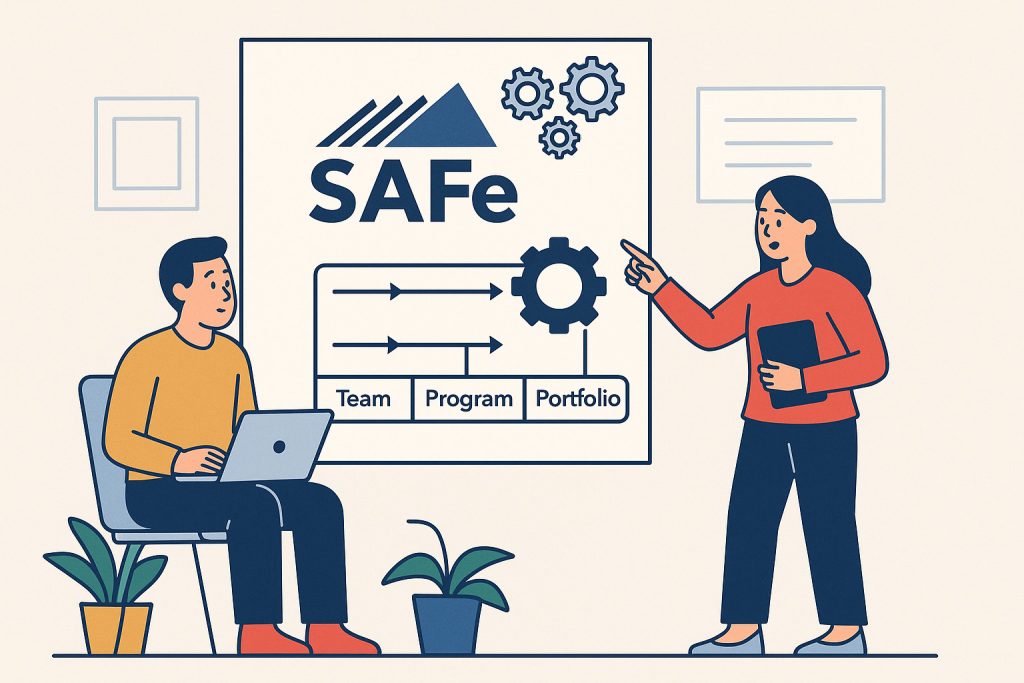Imagine trying to conduct an orchestra where each musician decides independently when to play their part. That’s essentially what happens when large organizations attempt to scale agile practices without a coordinating framework. While a jazz trio can improvise brilliantly together, a hundred-piece symphony needs a conductor and sheet music. This fundamental tension between creative autonomy and coordinated execution lies at the heart of why scaling methodologies exist at all.
What is the Scaled Agile Framework (SAFe)?
SAFe represents an attempt to bridge two seemingly incompatible worlds: the nimble, responsive culture of agile development and the structured, predictable operations that large enterprises require. At its essence, it’s a coordination system that allows numerous development squads to work simultaneously without stepping on each other’s toes or producing incompatible components.
The architecture operates across three distinct organizational altitudes. At ground level, small squads handle actual coding and feature development using familiar iterative practices. Mid-level coordination ensures these squads aren’t building in isolation—their outputs must integrate seamlessly into coherent product releases. At the strategic altitude, executives make investment decisions and set long-term direction that cascades down through the entire system.
What distinguishes this approach from other scaling attempts is its pragmatic borrowing from proven methodologies. Rather than inventing entirely new practices, it aggregates techniques from Lean manufacturing, Kanban visualization, Scrum iteration, and XP engineering, then provides patterns for deploying them harmoniously across organizational layers. It’s more compilation than invention, which partly explains its widespread adoption.
What’s the History of the Scaled Agile Framework?
The framework emerged from Dean Leffingwell’s observations of a recurring pattern in software enterprises during the early 2010s. Organizations would successfully pilot agile methods with small teams, witness impressive results, then struggle mightily when attempting broader rollout. The methodologies that worked beautifully at small scale created coordination nightmares at large scale.
Leffingwell’s background gave him a unique vantage point to address this disconnect. Having worked extensively in both technical and strategic roles, he understood why individual teams loved agile practices and why executives worried about predictability and coordination. His initial concept—which carried the unwieldy name “Agile Enterprise Big Picture”—attempted to map how different methodologies could coexist at different organizational levels while maintaining coherence.
The timing proved opportune. By 2011, enough enterprises had attempted and struggled with agile scaling that demand existed for systematic guidance. Rather than keeping the approach proprietary, Leffingwell made the entire knowledge base freely available, fostering a practitioner community that refined and evolved the patterns through real-world implementation. This open approach accelerated adoption and created feedback loops that improved the framework over time.
What are the SAFe Agile Principles
Underlying the framework sits a foundation of ten guiding principles—not rules, but conceptual anchors that help practitioners navigate ambiguous situations. These principles attempt to codify wisdom that emerged from numerous implementations about what actually matters when scaling agile practices.
Several principles address economic realities that organizations can’t ignore. Delivering value early and often beats perfect execution that arrives late. People closest to implementation details should make technical decisions rather than distant executives. Quality must be embedded in the development process rather than bolted on through inspection afterward.
Other principles focus on systemic thinking. Building architectural runway prevents teams from getting blocked by technical constraints. Synchronizing work cadences creates predictability without sacrificing adaptability. Limiting work in progress prevents the multitasking inefficiency that plagues many organizations. These aren’t revolutionary insights individually, but codifying them as foundational principles helps organizations maintain focus during implementation.
The real insight is recognizing that scaling agile means managing inherent tensions rather than resolving them. You need both stability and change, both autonomy and alignment, both local optimization and global coherence. The principles guide how to navigate these tensions productively rather than pretending they don’t exist.
SAFe Project Management
Work management under this framework manifests differently at each organizational layer, creating distinct experiences for different roles. An individual contributor might spend their day in standup meetings, pairing on code, and attending sprint retrospectives—activities that feel quite familiar to anyone who’s practiced Scrum. Their immediate world revolves around delivering incremental value within two-week cycles under guidance from a facilitator who removes impediments.
Move up to the program layer and the landscape shifts considerably. Here, Release Train Engineers orchestrate how multiple squads synchronize their efforts. Instead of individual teams shipping whenever ready, there’s a coordinated cadence where integrated increments get validated together approximately every ten weeks. This creates predictable delivery milestones while still maintaining iterative development within those timeframes. Dependencies get actively managed rather than discovered late, and architectural decisions get made with awareness of how they affect multiple teams.
At the portfolio layer, the perspective becomes strategic rather than tactical. Leaders at this altitude allocate investment across initiatives, evaluate whether the current project portfolio aligns with market opportunities, and make funding decisions that cascade down through the organization. They’re not tracking individual user stories but rather assessing whether the organization’s overall investment strategy makes sense given business objectives and market conditions.
Scaled Agile
The fundamental problem begins with a simple observation: agile practices were conceived for scenarios where a small group could maintain shared context through direct interaction. When everyone building a product can gather around a whiteboard daily, coordination happens organically through conversation. Decisions get made quickly because all stakeholders are present.
Scale breaks this dynamic completely. When your product involves forty microservices maintained by forty different squads, organic coordination becomes impossible. A database schema change in one service might affect a dozen downstream consumers. An API contract modification requires synchronized updates across mobile, web, and partner integrations. A user interface redesign needs consistent implementation across multiple product surfaces. Without explicit coordination mechanisms, these interdependencies create constant friction and frequent breakage.
This explains why scaling frameworks exist—not because anyone enjoys additional process, but because uncoordinated autonomy at scale produces incoherence. Consider how cloud infrastructure providers maintain consistency across dozens of interconnected services. Each service team has autonomy within defined boundaries, but those boundaries exist for good reason. Breaking changes go through deprecation cycles. Shared design patterns ensure consistent user experience. Cross-team architectural decisions happen through governance forums. These coordination mechanisms aren’t bureaucracy for its own sake—they’re necessary to maintain system coherence.
The alternative—complete team autonomy without coordination—sounds appealing in theory but collapses quickly in practice when teams actually depend on each other. You end up with duplicated effort, incompatible components, inconsistent user experiences, and constant firefighting as teams discover conflicts late in development. Some degree of coordination isn’t optional; the only question is whether it will be intentional or chaotic.
Scaling also changes how organizations relate to time. A small team can pivot daily based on user feedback. An enterprise coordinating hundreds of people needs longer planning horizons to give sales, marketing, support, and operations adequate lead time. This isn’t because enterprises are slow or bureaucratic—it’s because coordinating many moving parts requires advanced notice. Predictability becomes valuable, even at the cost of some responsiveness.
SAFe Versus Scrum
These frameworks address different problems rather than competing for the same space. Scrum provides excellent patterns for how individual teams should operate—the ceremonies, roles, and artifacts that enable iterative development. It assumes that coordination beyond the team happens informally or isn’t particularly complex.
This assumption holds beautifully for many situations. A team building a mobile application can own the entire stack—frontend, backend, infrastructure—and ship independently. Another team maintaining a legacy system can operate autonomously because few external dependencies exist. In these contexts, Scrum’s lightweight approach minimizes overhead while maximizing team flexibility.
But Scrum deliberately doesn’t address cross-team coordination challenges. How do you manage dependencies when Team A’s database changes affect Team B’s API? How do you ensure architectural consistency when fifteen teams are building different services? How do you synchronize releases when multiple components must ship together? These questions fall outside Scrum’s scope because it’s a team-level framework.
SAFe adds coordination layers specifically to address these gaps. It preserves Scrum-like practices at the team level but introduces program-level synchronization mechanisms and portfolio-level strategic planning. This necessarily constrains team autonomy—you can’t ship whenever you want if your component integrates with others shipping on a coordinated schedule. You can’t make arbitrary architectural choices if they affect shared infrastructure or other teams’ work.
The trade-off is straightforward: you sacrifice some local autonomy and speed to gain global coordination and coherence. Whether this exchange makes sense depends entirely on whether coordination challenges actually exist. For loosely coupled products with minimal interdependencies, the overhead exceeds the benefit. For tightly integrated platforms where everything connects to everything else, the coordination becomes essential.
What are the Strengths and Weaknesses of SAFe?
Every methodology makes choices about what to prioritize, creating both capabilities and limitations. Understanding SAFe’s trade-offs helps organizations decide whether it fits their context.
SAFe’s strengths include:
- Providing explicit patterns for dependency management and cross-team synchronization that would otherwise require constant ad-hoc coordination
- Creating visibility mechanisms that allow stakeholders to understand status without generating constant status reporting overhead
- Establishing clear connections between strategic portfolio decisions and tactical execution work, ensuring teams understand how their work connects to business objectives
SAFe’s weaknesses include:
- Demanding significant upfront investment in training, role definition, and process establishment before delivering value
- Introducing hierarchical coordination structures that can reduce team empowerment and slow decision-making
- Creating procedural complexity that may exceed what many organizations actually need for their coordination challenges
The certification ecosystem surrounding the framework reveals both maturity and formalization. Multiple role-specific training programs exist, ranging from two-day workshops to week-long immersions. This provides clear professional development paths and standardized knowledge, but also suggests a level of specialization that may feel at odds with agile’s original emphasis on cross-functional generalists who can flexibly contribute wherever needed.
Should You Use the Scaled Agile Framework?
Choosing whether to adopt this framework requires honest assessment of your actual coordination pain points. Three teams building independent services probably don’t need it. Fifty teams building an integrated platform where changes constantly ripple across boundaries probably do.
The framework found its strongest footing in enterprise contexts precisely because it addresses enterprise-specific challenges: coordinating hundreds of contributors, managing regulatory compliance requirements, providing predictability to business stakeholders, maintaining consistency across product families, and operating across geographic and organizational boundaries. These challenges rarely exist in startup environments but dominate life in established corporations.
Organizations new to agile sometimes find SAFe’s prescriptive nature helpful because it reduces ambiguity. Clear role definitions, specified ceremonies, and defined artifacts provide a roadmap. However, this comes at the cost of organizational learning—you’re implementing someone else’s solution rather than developing capacity to solve problems contextually. Whether this trade-off makes sense depends on your organization’s maturity and learning capacity.
The hierarchical coordination inherent in the framework deserves careful consideration. If you’re pursuing agile specifically to increase team autonomy, reduce planning overhead, and push decisions closer to execution, SAFe’s structured coordination layers might feel contrary to your objectives. The structure exists to solve coordination problems, but coordination itself can conflict with empowerment. Both matter; which matters more depends on your specific challenges.
No framework substitutes for genuine organizational change work. SAFe offers patterns, but those patterns only succeed when implemented thoughtfully with appropriate cultural adaptation. Mechanical adherence without understanding why practices matter typically produces disappointing results. The framework works when it matches real needs and when organizations invest in helping people understand not just what to do but why it matters.
Conclusion
The framework exists because enterprise software development presents coordination challenges that team-level agile practices weren’t designed to address. It trades some agile ideals—particularly around autonomy and minimal process—for coordination capabilities that large organizations often genuinely require. Whether this exchange benefits your specific context depends on the actual complexity you’re managing and the real coordination problems you’re experiencing. The framework isn’t inherently superior or inferior to simpler approaches—it’s optimized for different constraints and different scales. Organizations that implement it with clear understanding of these trade-offs and adapt it thoughtfully to their context often extract significant value. Those expecting it to make large organizations feel small and nimble will likely find it disappointing. Its real contribution isn’t eliminating the challenges of scale, but providing structured patterns for managing them more effectively than ad-hoc approaches typically achieve.


